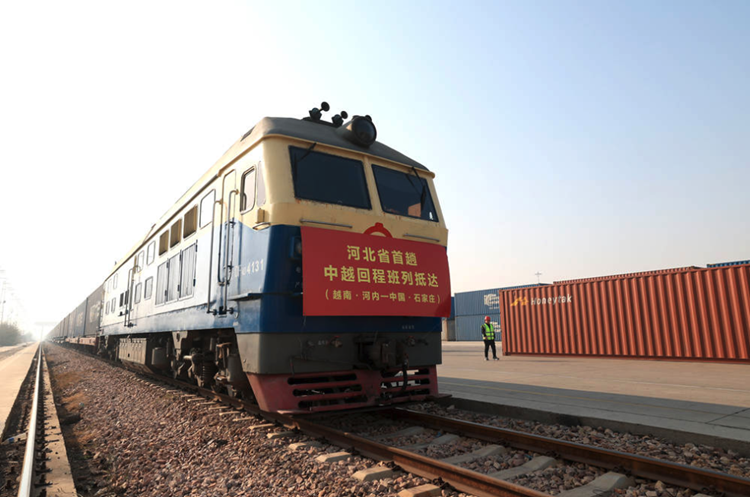In October, the early morning hours of the Vietnamese capital Hanoi Dongying station lights, cranes shuttle back and forth, will be a container loaded to the China-Vietnam shuttle train board, more than 500 tons of wood train then whistle to Guangxi, China.
This is the raw material for paper making purchased by Guangxi Chongzuo Liwen Pulp Products Co. Zhang Cunwei, Chairman of the Board of Directors of Vietnam International Dry Port Operation Joint Stock Company, said, “Previously, many liner is scattered goods into a liner, and now a liner with multiple containers is often the same kind of goods, and we also opened a variety of agricultural products and other special trains.”
Over the past few months, Zhang Cunwei for the upcoming opening of the fresh coconut special train many times to the main coconut producing areas in southern Vietnam. In August this year, China and Vietnam signed a protocol related to the export of fresh coconuts from Vietnam to China, the export of fresh coconuts from Vietnam to China is imminent. “As the operating platform of the China-Vietnam shuttle train, we are also making preparations in the hope of building a fast track for exporting Vietnamese fresh coconuts to China.”
Nguyen Hoang Anh, deputy general director of the Vietnam Railway Transportation and Trade Joint Stock Company, a subsidiary of the Vietnam Railways Corporation, told Xinhua that the Sino-Vietnamese liner train, which began in 2017 and initially carried mainly more basic cargoes, has grown to more than 300 kinds of goods. Vietnam's exports include agricultural products, electronic products, textiles, etc., while China's shipments to Vietnam are mainly raw materials and construction materials needed for processing and manufacturing.

Nguyen Hoang Anh introduced the China-Vietnam liner as a bidirectional pairing, delivering Vietnamese goods to more than 20 provinces and cities in China and connecting the China-Europe liner to Central Asia and European countries. Chinese goods are not only transported to Vietnam, but also into ASEAN countries such as Laos, Thailand, Cambodia and Malaysia via Vietnam.
“With the promotion and service support of the railroad departments of the two countries, more and more enterprises are choosing railroad transportation.” Nguyen Hoang Anh said the China-Vietnam liner can shorten the time of cargo transportation, reduce the cost of enterprises, and effectively promote trade between the two countries.
China has maintained the status of Vietnam's top trading partner for many years, and Vietnam is China's top trading partner in ASEAN. In the Sino-Vietnamese border of Guangxi Pingxiang Railway Port, crisscrossing the flow of freight cars is a vivid portrayal of the Sino-Vietnamese international trade in both directions.
“Today, five trains were opened in one day.” Xie Liping, assistant interpreter at Pingxiang Station of the Nanning Car Service Section of the Nanning Bureau of the State Railway, feels that the work is getting busier and busier after the regularization of the China-Vietnam shuttle train.
In 2017, the Nanning Bureau of the State Railway successfully debuted the Nanning-Henoi cross-border container train. From the start of less than 5 trains per month, to the first 7 months of this year, 3 times to refresh the single-month shipment volume, China-Vietnam shuttle train increasing rapidly. Data show that, as of September 30, this year, Guangxi began to ship goods in China-Vietnam shuttle train exceeded 10,000 TEUs, reaching 10,380 TEUs, a record high.
Behind this is inseparable from the efforts of China and Vietnam for the “two-way run to”. 2023 Nanning Bureau of the State Railway to complete the Xianggui Railway Nanning to Pingxiang section of the speed transformation, China-Vietnam International Railway Corridor train operating speed increased to 90 kilometers per hour.

“Originally, we exported PVC to Vietnam by sea, but now we can save 3 to 5 days by using the China-Vietnam shuttle train.” Zhu Shiqiang, business manager of Sinotrans Guangxi Co Ltd, said.
“Stable capacity, stable price and stable timeliness have enhanced the market attractiveness of the channel, which is now able to radiate to the southwest hinterland and the Guangdong-Hong Kong-Macao Greater Bay Area.” Peng Weijun, deputy director of the 95306 Freight Logistics Service Center of the State Railway Nanning Bureau Group Co., Ltd, said that this year, the State Railway Nanning Bureau has also organized the Guangzhou-Nanning-Vietnam “Railway+Railway” connecting train to open a new cross-border logistics corridor for the Guangdong-Hong Kong-Macao Greater Bay Area to export goods to Vietnam. Cross-border logistics channel.
In January 2024, the railroad companies of China and Vietnam negotiated and determined the timetable for the whole China-Vietnam liner train, significantly compressing the transportation time. The total length of transportation from Nanning South Station in China to An Phuong Station in Vietnam was compressed from more than 40 hours to the fastest 14 hours, significantly improving the transportation efficiency of the China-Vietnam liner train.
Nguyen Hoang Anh said that the Vietnamese government and railroad companies plan to further invest in improving railroad infrastructure such as stations and yard systems to strengthen the docking with China's railroads and enhance the transportation capacity between the two countries.

